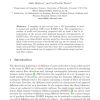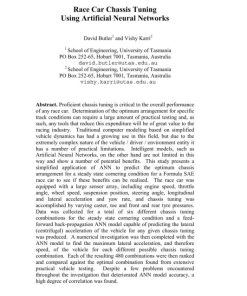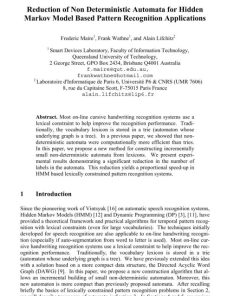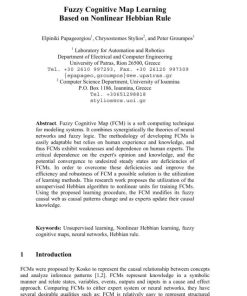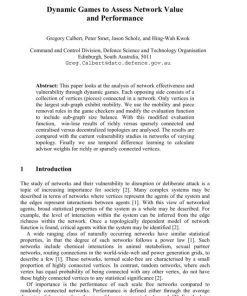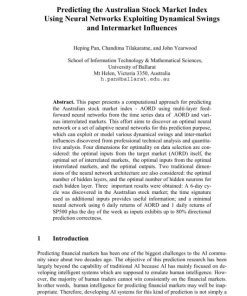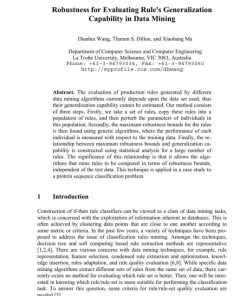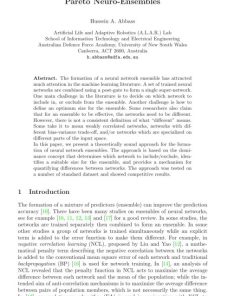LNAI 2903 Dynamic Variable Filtering for Hard Random 3SAT Problems 1st Edition by Anbulagan, John Thornton, Abdul Sattar ISBN 9783540206460 354020646X
$50.00 Original price was: $50.00.$25.00Current price is: $25.00.
Authors:A. Anbulagan, John Thornton; Abdul Sattar , Tags:AI 2003: Advances in Artificial Intelligence , Author sort:A. Anbulagan, John Thornton & Sattar, Abdul , Languages:Languages:eng , Published:Published:Nov 2003
LNAI 2903 Dynamic Variable Filtering for Hard Random 3SAT Problems 1st Edition by Anbulagan, John Thornton, Abdul Sattar – Ebook PDF Instant Download/Delivery. 9783540206460 ,354020646X
Full download LNAI 2903 Dynamic Variable Filtering for Hard Random 3SAT Problems 1st Edition after payment
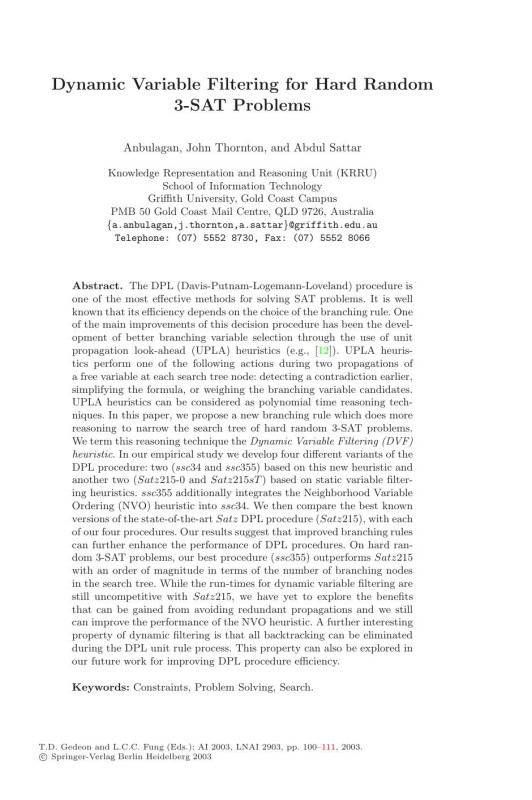
Product details:
ISBN 10: 354020646X
ISBN 13: 9783540206460
Author: Anbulagan, John Thornton, Abdul Sattar
The DPL (Davis-Putnam-Logemann-Loveland) procedure is one of the most effective methods for solving SAT problems. It is well known that its efficiency depends on the choice of the branching rule. One of the main improvements of this decision procedure has been the development of better branching variable selection through the use of unit propagation look-ahead (UPLA) heuristics (e.g., [12]). UPLA heuristics perform one of the following actions during two propagations of a free variable at each search tree node: detecting a contradiction earlier, simplifying the formula, or weighing the branching variable candidates. UPLA heuristics can be considered as polynomial time reasoning techniques. In this paper, we propose a new branching rule which does more reasoning to narrow the search tree of hard random 3-SAT problems. We term this reasoning technique the Dynamic Variable Filtering (DVF) heuristic. In our empirical study we develop four different variants of the DPL procedure: two (ssc34 and ssc355) based on this new heuristic and another two (Satz215-0 and Satz215sT) based on static variable filtering heuristics. ssc355 additionally integrates the Neighborhood Variable Ordering (NVO) heuristic into ssc34. We then compare the best known versions of the state-of-the-art Satz DPL procedure (Satz215), with each of our four procedures. Our results suggest that improved branching rules can further enhance the performance of DPL procedures. On hard random 3-SAT problems, our best procedure (ssc355) outperforms Satz215 with an order of magnitude in terms of the number of branching nodes in the search tree. While the run-times for dynamic variable filtering are still uncompetitive with Satz215, we have yet to explore the benefits that can be gained from avoiding redundant propagations and we still can improve the performance of the NVO heuristic. A further interesting property of dynamic filtering is that all backtracking can be eliminated during the DPL unit rule process. This property can also be explored in our future work for improving DPL procedure efficiency.
LNAI 2903 Dynamic Variable Filtering for Hard Random 3SAT Problems 1st Edition Table of contents:
Chapter 1: Introduction
-
1.1 Motivation for Studying Random 3SAT Problems
-
1.2 Overview of Dynamic Variable Filtering
-
1.3 Research Objectives
-
1.4 Contributions of the Work
Chapter 2: Background and Related Work
-
2.1 SAT Problems and Complexity
-
2.2 Random 3SAT Problem Characteristics
-
2.3 Existing Techniques for SAT Solving
-
2.4 Limitations of Current Approaches
Chapter 3: Dynamic Variable Filtering Framework
-
3.1 Core Principles of Dynamic Filtering
-
3.2 Algorithmic Description
-
3.3 Example Applications
-
3.4 Implementation Details
Chapter 4: Experimental Setup
-
4.1 Problem Instances and Benchmark Selection
-
4.2 Computational Environment
-
4.3 Metrics for Evaluation
-
4.4 Baseline Algorithms
Chapter 5: Results and Analysis
-
5.1 Performance on Hard Random 3SAT Instances
-
5.2 Comparison with Baseline Methods
-
5.3 Sensitivity Analysis of Filtering Parameters
-
5.4 Discussion of Key Findings
Chapter 6: Extensions and Applications
-
6.1 Extensions to Other SAT Variants
-
6.2 Applications in Real-World Problems
-
6.3 Integration with Hybrid Solvers
Chapter 7: Conclusion and Future Work
-
7.1 Summary of Findings
-
7.2 Implications for SAT Solving
-
7.3 Open Questions and Future Research Directions
References
-
Comprehensive list of cited works.
People also search for LNAI 2903 Dynamic Variable Filtering for Hard Random 3SAT Problems 1st Edition:
dynamic filtering excel
dynamic filter function in excel
dynamic variable matlab
dynamic randomization example
You may also like…
eBook PDF
LNAI 2903 Pareto Neuro Ensembles 1st Edition by Hussein Abbass ISBN 9783540206460 354020646X


